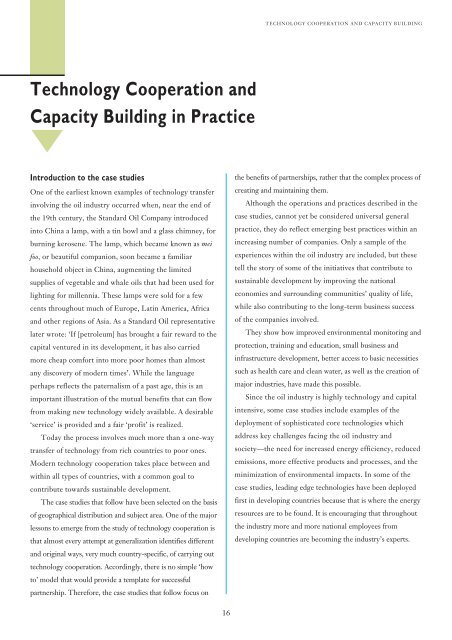Technology Cooperation and Capacity Building - CommDev
Technology Cooperation and Capacity Building - CommDev
Technology Cooperation and Capacity Building - CommDev
Create successful ePaper yourself
Turn your PDF publications into a flip-book with our unique Google optimized e-Paper software.
TECHNOLOGY COOPERATION AND CAPACITY BUILDING<strong>Technology</strong> <strong>Cooperation</strong> <strong>and</strong><strong>Capacity</strong> <strong>Building</strong> in Practice▼Introduction to the case studiesOne of the earliest known examples of technology transferinvolving the oil industry occurred when, near the end ofthe 19th century, the St<strong>and</strong>ard Oil Company introducedinto China a lamp, with a tin bowl <strong>and</strong> a glass chimney, forburning kerosene. The lamp, which became known as meifoo, or beautiful companion, soon became a familiarhousehold object in China, augmenting the limitedsupplies of vegetable <strong>and</strong> whale oils that had been used forlighting for millennia. These lamps were sold for a fewcents throughout much of Europe, Latin America, Africa<strong>and</strong> other regions of Asia. As a St<strong>and</strong>ard Oil representativelater wrote: ‘If [petroleum] has brought a fair reward to thecapital ventured in its development, it has also carriedmore cheap comfort into more poor homes than almostany discovery of modern times’. While the languageperhaps reflects the paternalism of a past age, this is animportant illustration of the mutual benefits that can flowfrom making new technology widely available. A desirable‘service’ is provided <strong>and</strong> a fair ‘profit’ is realized.Today the process involves much more than a one-waytransfer of technology from rich countries to poor ones.Modern technology cooperation takes place between <strong>and</strong>within all types of countries, with a common goal tocontribute towards sustainable development.The case studies that follow have been selected on the basisof geographical distribution <strong>and</strong> subject area. One of the majorlessons to emerge from the study of technology cooperation isthat almost every attempt at generalization identifies different<strong>and</strong> original ways, very much country-specific, of carrying outtechnology cooperation. Accordingly, there is no simple ‘howto’ model that would provide a template for successfulpartnership. Therefore, the case studies that follow focus onthe benefits of partnerships, rather that the complex process ofcreating <strong>and</strong> maintaining them.Although the operations <strong>and</strong> practices described in thecase studies, cannot yet be considered universal generalpractice, they do reflect emerging best practices within anincreasing number of companies. Only a sample of theexperiences within the oil industry are included, but thesetell the story of some of the initiatives that contribute tosustainable development by improving the nationaleconomies <strong>and</strong> surrounding communities’ quality of life,while also contributing to the long-term business successof the companies involved.They show how improved environmental monitoring <strong>and</strong>protection, training <strong>and</strong> education, small business <strong>and</strong>infrastructure development, better access to basic necessitiessuch as health care <strong>and</strong> clean water, as well as the creation ofmajor industries, have made this possible.Since the oil industry is highly technology <strong>and</strong> capitalintensive, some case studies include examples of thedeployment of sophisticated core technologies whichaddress key challenges facing the oil industry <strong>and</strong>society—the need for increased energy efficiency, reducedemissions, more effective products <strong>and</strong> processes, <strong>and</strong> theminimization of environmental impacts. In some of thecase studies, leading edge technologies have been deployedfirst in developing countries because that is where the energyresources are to be found. It is encouraging that throughoutthe industry more <strong>and</strong> more national employees fromdeveloping countries are becoming the industry’s experts.16















![[PDF] Community Development Toolkit - CommDev](https://img.yumpu.com/48616495/1/184x260/pdf-community-development-toolkit-commdev.jpg?quality=85)
